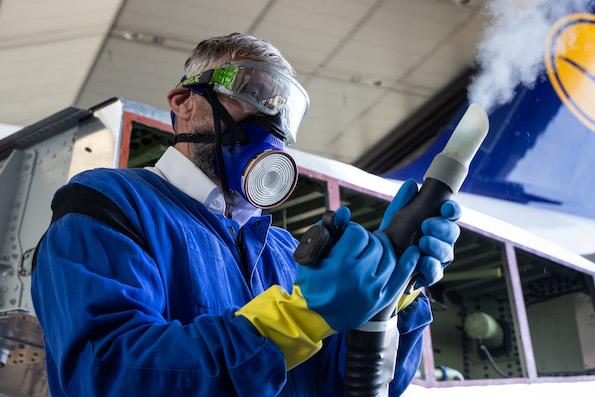
Deep cleaning during major checks provides a more effective and less environmentally damaging method of avoiding microbial film buildup in fuel tanks than adding hazardous chemicals, Lufthansa Technik argues.
GENEVA—Product launches usually focus on describing a new offering and highlighting its usefulness to the target market. But at the European Business Aviation Conference and Exhibition here, Lufthansa Technik is trying something more ambitious.
The company is promoting a new fuel tank cleaning process designed to solve a problem that could cause considerable damage and correspondingly high costs for some aircraft operators. But Lufthansa Technik (LT) is also seeking to start a conversation across the industry that it hopes may lead to changes in aircraft maintenance manuals and regulations.
The procedure is called fuel tank sanitization, and it has been developed in response to problems LT saw when some customer aircraft were coming through maintenance, repair and overhaul facilities for regular maintenance layovers. In certain hot and humid environments, and particularly with aircraft that experienced long gaps between flights, microbes in the fuel tanks can turn into a film, clogging filters and potentially corroding the tanks.
Aircraft OEMs and current regulations resolve this issue by mandating that chemicals be added to the tanks to disperse and destroy the microbial film, but this is not a perfect solution. LT believes its approach—involving the use of steam cleaning and vacuum suction during heavy checks, when tanks are inspected for structural integrity—will completely remove the film, without the need to add hazardous chemicals that could corrode the tanks and would eventually exit via the engine tailpipe when fuel is burned.
“In various cases, the biocides were not that effective,” company spokesman Michael Lagemann told Aviation Week Network ShowNews at EBACE 2024. “It killed the microbes the first time, but microbial aggregations remained in the tank.” Within a few months, the clogging problems returned. “If you really clean it—sanitize it—one time, you’re safe for quite a while,” Lagemann added. “You make sure it won’t come back.”
LT can carry out the process under its existing Part 21J approvals, but there is no way to avoid also adding the biocides.
“That’s why we’re here—seeking discussions with operators and authorities,” Lagemann said. “Currently, almost all [aircraft maintenance manuals] mandate biocide treatments. So we use our procedure and have to use biocides in addition. But we want our solution to show that there can be a better way to maybe, finally, in the future, get rid of them.”





